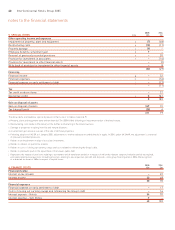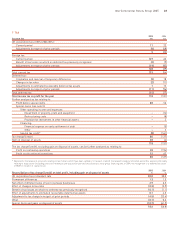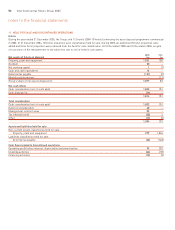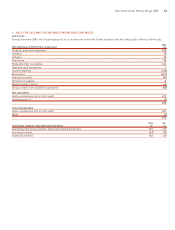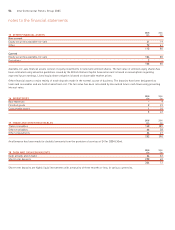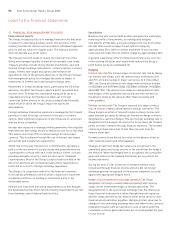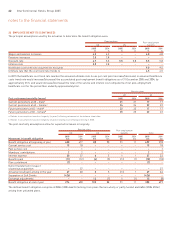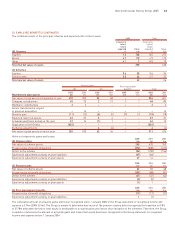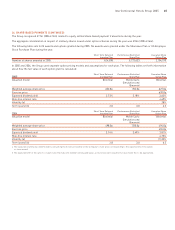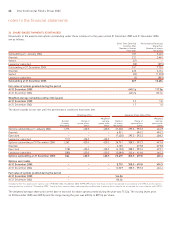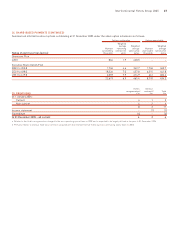Holiday Inn 2005 Annual Report Download - page 60
Download and view the complete annual report
Please find page 60 of the 2005 Holiday Inn annual report below. You can navigate through the pages in the report by either clicking on the pages listed below, or by using the keyword search tool below to find specific information within the annual report.
21 FINANCIAL RISK MANAGEMENT POLICIES
Financial instruments
The Group’s treasury policy is to manage financial risks that arise
in relation to underlying business needs. The activities of the
treasury function are carried out in accordance with Board approved
policies and are subject to regular audit. The treasury function
does not operate as a profit centre.
The treasury function seeks to reduce the financial risk of the
Group and manages liquidity to meet all foreseeable cash needs.
Treasury activities include money market investments, spot and
forward foreign exchange instruments, currency options, currency
swaps, interest rate swaps and options and forward rate
agreements. One of the primary objectives of the Group’s treasury
risk management policy is to mitigate the adverse impact of
movements in interest rates and foreign exchange rates.
Movements in foreign exchange rates, particularly the US dollar
and euro, can affect the Group’s reported profit, net assets and
interest cover. To hedge this translation exposure as far as is
reasonably practical, borrowings are taken out in foreign
currencies (either directly or via currency swaps) which broadly
match those in which the Group’s major net assets are
denominated.
Foreign exchange transaction exposure is managed by the forward
purchase or sale of foreign currencies or the use of currency
options. Most significant exposures of the Group are in currencies
that are freely convertible.
Interest rate exposure is managed within parameters that stipulate
that fixed rate borrowings should normally account for no less than
25% and no more than 75% of net borrowings for each major
currency. This is achieved through the use of interest rate swaps
and options and forward rate agreements.
Credit risk on treasury transactions is minimised by operating a
policy on the investment of surplus funds that generally restricts
counterparties to those with an A credit rating or better, or those
providing adequate security. Limits are also set for individual
counterparties. Most of the Group’s surplus funds are held in the
UK or US and there are no material funds where repatriation is
restricted as a result of foreign exchange regulations.
The Group is in compliance with all of the financial covenants
in its loan documentation, none of which is expected to represent
a material restriction on funding or investment policy in the
foreseeable future.
Medium and long-term borrowing requirements are met through
the Syndicated facility. Short-term borrowing requirements are met
from drawings under bilateral bank facilities.
Sensitivities
Based on the year end net debt position and given the underlying
maturity profile of investments, borrowings and hedging
instruments at that date, a one percentage point rise in US dollar
interest rates would increase the net interest charge by
approximately £1m, whilst a similar movement in euro interest
rates would increase the net interest charge by approximately £4m.
A general weakening of the US dollar (specifically a one cent rise
in the sterling:US dollar rate) would have reduced the Group’s
profit before tax by an estimated £1m.
Hedging
Interest rate risk The Group hedges its interest rate risk by taking
out interest rate swaps to fix the interest flows on between 25%
and 75% of its borrowings in major currencies. At 31 December
2005, the Group held interest rate swaps with notional principals
of USD200m and EUR160m (2004 USD200m, AUD60m, HKD300m
and EUR215m). The interest rate swaps are designated as cash
flow hedges of the syndicated loan facility and they are held on
the balance sheet at fair value in other financial assets and
other payables.
Foreign currency risk The Group is exposed to foreign currency
risk on income streams denominated in foreign currencies. The
Group hedges a portion of forecast foreign currency income and
asset disposal proceeds by taking out forward exchange contracts
designated as cash flow hedges. The spot foreign exchange rate is
designated as the hedged risk and so the Group takes the forward
points on these contracts through financial expenses. The forward
contracts all have maturities of less than one year from the
balance sheet date.
Forward contracts are held at fair value on the balance sheet as
other financial assets and other payables.
Changes in cash flow hedge fair values are recognised in the
unrealised gains and losses reserve to the extent that the hedges
are effective. When the hedged item is recognised, the cumulative
gains and losses on the hedging instrument are recycled to the
income statement.
During the year, £1.3m of interest on forward contracts was
recognised through financial income and a £4.6m net foreign
exchange gain was recognised in the income statement, recycled
against the appropriate hedged items.
Hedge of net investment in a foreign operation The Group
designates its foreign currency bank borrowings and currency
swaps as net investment hedges of foreign operations. The
designated risk is the spot foreign exchange risk; the interest on
these financial instruments is taken through financial expenses
and the swaps are held on the balance sheet at fair value in other
financial assets and other payables. Variations in fair value due to
changes in the underlying exchange rates are taken to the currency
translation reserve until an operation is sold, at which point the
cumulative currency gains and losses are recycled against the gain
or loss on sale.
notes to the financial statements
58 InterContinental Hotels Group 2005


